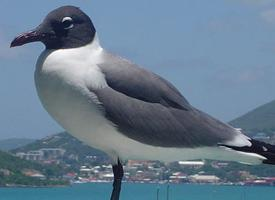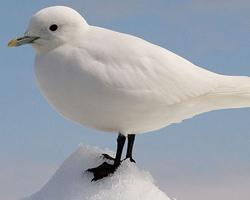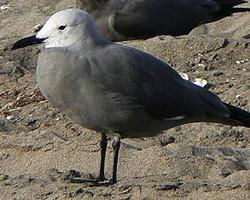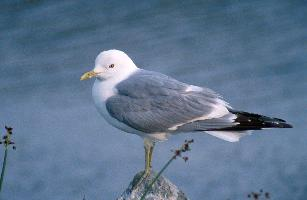
Stav ohrožení
| Ohrožen |
Popis zvířete
The Laughing Gull (Leucophaeus atricilla), named for its raucous laugh-like call, is a medium-sized gull that is a familiar sight along the coasts of North and South America. With a distinctive appearance and behavior, this bird has captivated birdwatchers and nature enthusiasts alike.Adult Laughing Gulls are easily recognizable by their striking plumage during the breeding season. They sport a deep black hood that contrasts sharply with their white underparts. Their back and wings are a sleek gray, and the wingtips are black with white spots, known as "mirrors." The bill is a vibrant red, and the legs are a dark, reddish-black, adding to their striking appearance. In the winter, their plumage undergoes a transformation, with the black hood receding to reveal a white head with smudgy gray spots, and their bill and legs fade to a duller color.
Juvenile Laughing Gulls undergo several stages of plumage development, starting with a mottled brown and gray appearance, gradually transitioning to the adult plumage over a couple of years. This process provides an interesting study for birdwatchers, as the plumage gives clues about the age of the bird.
One of the most distinctive features of the Laughing Gull is its call. The high-pitched, laugh-like sound is a common chorus in coastal and nearshore environments, particularly during the breeding season. This call is not only a means of communication among gulls but also adds a unique auditory backdrop to their habitats.
Laughing Gulls are versatile feeders, adapting their diet to the available resources. They are omnivorous, feeding on a wide range of items from fish and invertebrates to insects, and even food scraps from humans. Their feeding behavior is equally adaptable, including scavenging, surface dipping, and catching prey in flight.
Breeding occurs in large colonies, typically on islands free from terrestrial predators. Nest sites are on the ground, where the gulls lay two to three eggs. Both parents share in the incubation duties and in feeding the growing chicks. The social structure within these colonies is complex, with birds often engaging in both cooperative and competitive interactions.
The habitat of the Laughing Gull spans a wide range along the Atlantic coast of North America, from Canada to Venezuela, and throughout the Caribbean. They are a common sight on beaches, marshes, and nearshore waters, often mingling with other species of gulls. During the winter months, many migrate to the warmer waters of the Caribbean and the northern coasts of South America.
Conservation efforts have helped to stabilize populations of Laughing Gulls, which had previously faced threats from habitat loss and pollution. Today, they are considered a species of least concern by conservation organizations, reflecting their current stable status. However, they remain indicators of the health of coastal ecosystems, and continued conservation efforts are essential to ensure their habitats are preserved.
In summary, the Laughing Gull is a fascinating and adaptable bird, with distinctive calls and plumage that make it a favorite among birdwatchers. Its presence along the coasts of the Americas adds vibrancy and life to these ecosystems, making it an integral part of the coastal avifauna.
Podobná zvířata
Nové fotografie zvířat
Top 10 zvířat
- Chinese water dragon (Physignathus cocincinus)
- Galápagos tortoise (Geochelone nigra complex)
- Dolphin gull (Leucophaeus scoresbii)
- Japanese macaque (Macaca fuscata)
- Colombian red howler (Alouatta seniculus)
- Sea urchins (Echinoidea)
- Diana monkey (Cercopithecus diana)
- Moustached guenon (Cercopithecus cephus)
- Colossal squid (Mesonychoteuthis hamiltoni)
- Common house mosquito (Culex pipiens)


